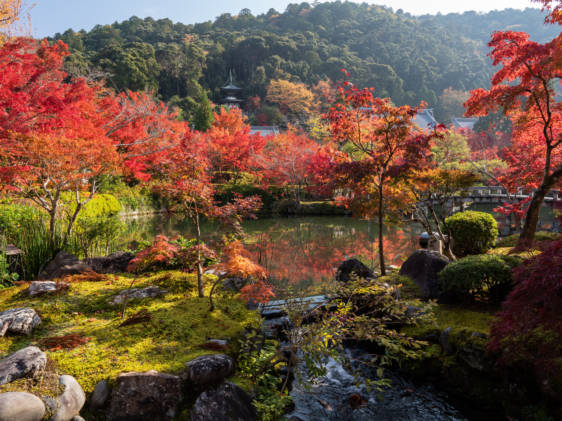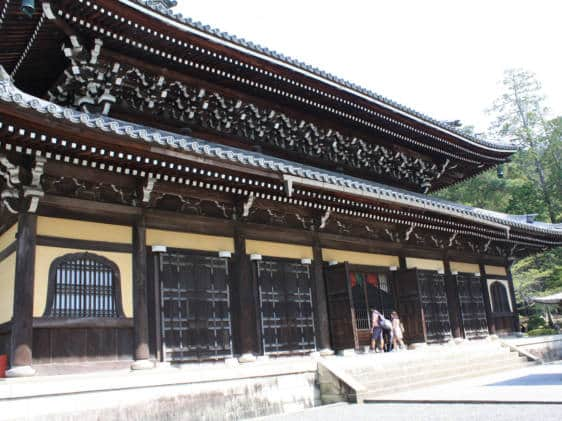The Philosopher’s Path in Kyoto is more than a quiet meander along a canal. It’s also a chance to experience the changing seasons and explore a different side of Kyoto.
Tetsugaku no michi, as the Philosopher’s Path is called in Japanese, is especially popular when the cherry blossoms bloom in spring and when the leaves change color in fall. And don’t worry: it has other charms throughout the year.
The walk is also great way to see some temples and shrines — with mini-detours to well-known and lesser-visited options aplenty. We recommend beginning at the north end, near Ginkaku-ji, and heading out early, before things get too crowded.
What is the Philosopher’s Path?

The Philosopher’s Path is a fairly flat, 2 km-long path that stretches alongside a canal in Kyoto’s Higashiyama District. Even though it’s not very long, walking the Philosopher’s Path can fill many hours — because of all those detours you’ll want to take.
The path gained its name thanks to the influential Meiji era philosopher, Kitarō Nishida, who walked this path on his way to work at prestigious Kyoto University. Nishida founded the Kyoto School of Philosophy, and his daily walk was a part of his meditative practice.
While nowadays the crowds and cafés might be a bit of a distraction, the Philosopher’s Path is still a place for meditation. The countless shrines, temples, and smaller spiritual sites found on side streets offer focused points for thought. Along the path itself, take your time to appreciate the sounds of water and birdsong. And of course, the relaxing sight of flowing water and the signs of seasonal change around you, too.
Experiencing the seasons along the Philosopher’s Path

The Philosopher’s Path is a great place to visit year round, as the scenery offers something unique for every season. While spring gets the most crowds, the colder months also have their highlights, too. Afterall, what could be better than a brisk walk in the (nearby) mountain air on a winter’s day?
The Philosopher’s Path in spring
Unsurprisingly, spring is by far the most popular time to visit, especially when the sakura (cherry blossoms) bloom. Prepare to see traditional hanami (cherry blossom viewing) parties with locals and visitors alike. The cafés and food stalls will be in their element during this time, and you’ll be spoiled for choice (but also battling for a seat).
Discover other popular cherry blossom spots in Kyoto.
Summer
During summer, a magical event takes place along the water, with fireflies appearing as dusk falls. As the hot days begin to cool, these glowing beauties transform the Philosopher’s Path into an anime-esque scene. Bring something to sit on and keep your eyes peeled — whether you’ve seen them before or not, the fireflies are pretty amazing.
Fall and winter

An added bonus of cherry trees is that in the fall, their leaves become a fantastic palette of golden browns. Compared to spring, the fall leaves are a slightly more somber affair though. In winter, soft snow sometimes coats the ground, offering a magical winter scene.
Sights, shrines, and temples
The path has a whole host of tempting detours which will distract you on your stroll, including plenty of spiritual spots.
Ginkaku-ji

Starting off with a pretty famous one, Ginkaku-ji, known as the Silver Pavilion, is the lesser-visited sister of the world-renowned Golden Pavilion, Kinkaku-ji. Highlights include the moss garden and the Sea of Silver Sand complete with sand cone, known as the moon-viewing platform.
Hōnen-in

This understated but atmospheric place is a great detour. The moss-covered gate sits above worn steps and invites you to walk between sand mounds to achieve purification. Once inside (and purified), make sure to see the stone bridge, the mini-art show in the storehouse, and the secret area behind the main hall.
Eikan-dō
Eikan-dō was founded by a student of the monk Kūkai and is known for its fall colors. Make sure to check out the small rock garden, the Tahoto Pagoda, and the very pretty Hōjō Pond. If you’re around in fall, then be sure to head over for their evening illuminations — although expect crowds, it’s very popular!
Ōtoyo-jinja
A small shrine with a totally-worthwhile reason to visit: The mice statues guarding the entrance. Forget the usual foxes, this place does things its own way — and it’s cuter than you might expect.
The shrine is dedicated to the god Ōkuninushi, who had a great relationship with mice (after they saved him from a fiery death at the hands of his beloved’s father). The mice offer good luck for childbirth and learning, and the shrine is a particularly popular spot for those born in the year of the rat.
Nanzen-ji
One of the most important Zen temples in all of Japan, Nanzen-ji dates back to the 13th century. It has an especially impressive sanmon (the large wooden entrance gate), which was constructed in 1628. You can still climb onto the gate’s balcony for views across the city — and all this before you’re even in the temple grounds.
Inside, you’ll find rock gardens, beautiful paintings, and a little further, a surprising addition: A giant brick aquaduct stands just outside the hōjō (the former head priest’s residence). Built in the Meiji period, it once carried goods from Lake Biwa to Kyoto.
Cafés and restaurants around the Philosopher’s Path

Be sure to factor in a coffee break: As the popularity of the path grows, more and more cafés and shops are popping up. Since the canal was originally built to revitalize the area’s economy (back in the Meiji period), it’s kind of bringing the project full circle with local businesses thriving alongside the water.
We recommend Komichi, a little cafe serving shaved ice and tea — perfect in the warmer months. Kanoshojuan Teahouse is another great option; it’s a traditional spot serving matcha, seasonal desserts, and other sweets.
If you’re around in the evening, Monk is a smart restaurant that serves 7-course dinners for ¥13,200. Relying on fresh, seasonal produce, the menu changes frequently and is a great way to treat yourself after a day’s exploring. They have two serving times: 5 p.m. and 8 p.m. — we recommend you reserve in advance (you can do so online in English).
Rickshaw rides around the Philosopher’s Path
At various locations along the Philosopher’s Path rickshaws offer their services. This is an old-fashioned form of transport using the impressive leg-power of the men pulling the carts. If you haven’t tried one it can be pretty fun — it’s a popular date activity, but is nice with friends, too. It costs around ¥8,000 for half an hour but you can try it for 10 minutes for around ¥3,000 (prices vary).
Getting to the Philosopher’s Path
From Kyoto Station take bus no. 5 or 17 to the stop called “Ginkakuji-michi.” This stop is just a short walk from Ginkaku-ji, at the northern end of the Philosopher’s Path.
Alternatively, you could catch bus no. 32 to “Miyanomaechō” and start from the southern end; owever, bus no. 32 doesn’t go to Kyoto Station, so consult the route map to work out the most convenient option for you. Whatever bus you take, it’ll have a flat fare of ¥230.
If you’d prefer to take a train or the subway, the closest stop to Ginkaku-ji is Demachiyanagi Station; both the Keihan Main Line and the Eizan Main Line stop there. From Demachiyanagi Station, it’s still about a 30-minute walk (or 20-minute bus ride) to Ginkaku-ji. Another option is to take the Tozai subway to Keage Station and walk about 10 minutes to Nanzen-ji.
While we do our best to ensure it’s correct, information is subject to change. Post first published in January 2016. Last updated in February 2023 by Maria Danuco.


































